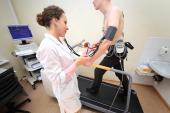Small Improvements in Fitness Add Up to Big Mortality Gains, Study Finds
The powerful predictive nature of cardiorespiratory fitness speaks to the need to more often measure it—and maintain it.

In adults with and without CVD, small and measurable improvements in cardiorespiratory fitness can be powerful predictors of future risk of all-cause mortality, new data suggest.
“Even a little bit of fitness, like a brisk walk most days of the week for approximately 30 minutes, may be the most effective way and perhaps the least expensive way to promote health for all ages,” lead author Peter Kokkinos, PhD (Washington DC Veterans Affairs Medical Center), told TCTMD. “I think it’s important to emphasize to the public that it really doesn't take a whole lot to reap the benefits of exercise.”
In the study, published today in the Journal of the American College of Cardiology, Kokkinos and colleagues assigned participants a simplified value—an age-specific peak metabolic equivalent (MET) from an initial exercise treadmill test and a follow-up test a few years later. Over a period of roughly 6 years, individuals who had MET improvements of as little as 1.0 between the two tests had lower risk of death independent of other comorbidities than those with no change or a decline in MET value.
The impact of increasing or decreasing MET values on mortality risk was seen across all fitness categories regardless of baseline cardiorespiratory fitness. But for those with the highest level of fitness, the study suggests there may be a protective “buffer” that can give them a survival edge, Kokkinos said.
“For the fittest people, those in quartile 4, it didn't matter if their fitness declined by more than 2 METs. Their mortality risk was not significantly affected,” he explained. “What this suggests is that you can drop your fitness level for whatever reason and you're still kind of protected up to a point.”
That being said, while the buffer conveys an advantage, it doesn’t mean people should slack off on fitness, only that working toward a higher level of cardiorespiratory fitness is a good health investment and that being derailed from your exercise plan by illness or injury for a short period is less of an issue if your fitness is high, Kokkinos noted.
Commenting on the study for TCTMD, Claudio Gil Araújo, MD, PhD (CLINIMEX, Rio de Janeiro, Brazil), called the results “amazing” and “very consistent” for subjects both with and without CVD. “The study adds a significant contribution to the available body of knowledge in the area,” he said in an email.
Inverse and Proportional Changes in Risk
The study included 93,060 participants (mean age 61 years; 5.4% female; 20% Black) from the Veterans Affairs’ Exercise Testing and Health Outcomes Study (ETHOS) cohort in Washington, DC, who had no evidence of overt CVD when they underwent an initial exercise treadmill test. The average time to repeat treadmill test was 5.8 years, and the average follow-up of participants was 6.3 years.
Based on their initial treadmill test, participants were assigned to one of four age-specific fitness quartiles where quartile 1 was the least fit, based on peak METs, and quartile 4 was the most fit. After the second treadmill test, they were further stratified based on increase, decrease, or no change in MET value.
Approximately one-quarter of participants had no change in their MET value, 29% had an increase and 46% had a decrease.
For those with CVD in quartile 1 or 2, indicating low fitness, a decrease of 2 or more METs was associated with increased risks of all-cause mortality amounting to 49% and 74%, respectively (P < 0.02 and P ≤ 0.002). For those in quartile 4, the highest level of fitness, however, a decrease of 2 or more METs was associated with a 37% increased risk of all-cause mortality (P ≤ 0.004).
In participants with CVD in quartiles 1-3, an increase of less than or more than 2 METs was associated with declines in all-cause mortality risk in a stepwise fashion, with the greatest benefits in those in higher quartiles. Those in quartile 4 who increased their MET value by 2 or more saw the greatest decline in risk of all groups at more than 50%.
The findings were similar in those without CVD, with the exception that those in quartile 3 (moderately fit) who had an increase in MET value of 2 or more saw the same decline in mortality risk as the fittest quartile with CVD. Those in quartile 4 without CVD had negligent changes in increased risk with declines in MET value of 2 or more.
Routine Cardiorespiratory Assessment Needed
Kokkinos and colleagues say the findings help simplify the role of cardiorespiratory fitness as a health predictor that needs more focus and attention from physicians and patients. It also supports the most-recent World Health Organization (WHO) guidelines recommending that adults perform at least 150 to 300 minutes per week of moderate-intensity exercise or 75 to 150 minutes of vigorous-intensity exercise. Even for a sedentary person, that could be as little as 30 minutes, five times a week.
It’s easy for people to get confused with all the noise that goes on about exercise and how much you should do, Kokkinos said. “We know physicians are very busy . . . but they should at least have a standard questionnaire where they are asking [at each visit]: Do you exercise? How much do you exercise? Is it enough to break a sweat? How long has it been that you have not been exercising?”
For those in the latter category, he said an exercise prescription may be warranted, especially if there is a history of CVD.
Indeed, Araújo pointed out that a cardiorespiratory fitness increase of 2 or more METs in 5 years, which only occurred in a fraction of subjects here, is something that could feasibly be achieved by adhering to a “well-prescribed exercise plan” and was associated with a two or three times lower risk of all-cause mortality in all of the subgroups tested. As such, he estimated, “the survival impact of increasing CRF by ≥ 2 METs in individuals with CVD probably exceeds what can be obtained by following the best possible combination of recommended drugs and/or revascularization procedures. Let' s place exercise recommendation as the first item/top on the list of medical prescription for CVD patients.”
In an editorial, Leonard A. Kaminsky, PhD (Ball State University, Muncie, IN), and colleagues say the finding reinforce previous observations in smaller studies about the powerful predictive nature of cardiorespiratory fitness.
“In fact, the prognostic utility of [it] outperforms commonly assessed clinical CVD risk factors, such as lipids, blood pressure, body habitus, smoking, and blood glucose,” they write. Despite its potential, they say it is rarely taken advantage of for that purpose, reserved instead as a gauge for diagnostic issues or transplant candidacy.
Kaminsky and colleagues also note that while there is a natural decline in cardiorespiratory fitness as people age, most can gain a 1- or 2-MET increase fairly easily or at the very least maintain their fitness throughout their life span. As advocated by the American Heart Association, they say, physicians should assess cardiorespiratory fitness routinely, just as they would for any other vital sign, and modify physical activity recommendations for those with suboptimal fitness for their age and sex.
L.A. McKeown is a Senior Medical Journalist for TCTMD, the Section Editor of CV Team Forum, and Senior Medical…
Read Full BioSources
Kokkinos P, Faselis C, Samuel IBH, et al. Changes in cardiorespiratory fitness and survival in patients with or without cardiovascular disease. J Am Coll Cardiol. 2023;81:1137-1147.
Kaminsky LA, Imboden MT, Ozemek C. It’s time to (again) recognize the considerable clinical and public health significance of cardiorespiratory fitness. J Am Coll Cardiol. 2023;81:1148-1150.
Disclosures
- Kokkinos and Kaminsky report no relevant conflicts of interest.





Comments